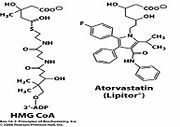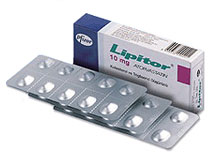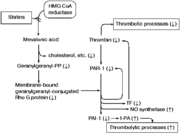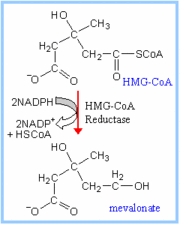Sandbox 55
From Proteopedia
| Please do NOT make changes to this Sandbox. Sandboxes 30-60 are reserved for use by Biochemistry 410 & 412 at Messiah College taught by Dr. Hannah Tims during Fall 2012 and Spring 2013. |
|
Contents |
Atorvastatin
Atorvastatin, commercially known as Lipitor is a 3-hydroxy-3-methyl-glutaryl-CoA reductase (HMG-CoA Reductase) inhibitor that works primarily in the liver[1]. It is part of a class of medications known as statins that are cholesterol-lowering medications[2]. HMG-CoA reductase catalyzes the committed step in cholesterol synthesis, so by inhibiting this step, low density lipoprotein (LDL) cholesterol can be effectively lowered as well as increasing high density lipoprotein (HDL) levels. By lowering LDL, the likelihood of stroke and heart attack can be decreased particularly in patients with hypercholesterolemia, mixed dyslipidemia, and homozygous familial hypercholesterolemia[3].
Bruce Roth, a Phizer employee, first synthesized atorvastatin in 1985. In 2008 Lipitor was the top-selling pharmaceutical in the world with $12.4 billion in sales. However, Lipitor's US patent protection is scheduled to expire in June 2011[4].
Chemical Properties
Formula: C33H35FN2O5
Molecular Mass: 558.64 g/mol
Half life: 14 hours
Half-life of HMG-CoA inhibitor activity: 20-30 hours
Structure and Synthesis
When synthesizing a statin, four properties need to be taken into consideration: high affinity for the HMG-CoA reductase active site, selective uptake into hepatic cells instead of non-hepatic cells, low endogenous inhibitory equivalents, and a relatively long half-life/duration of effect.
The essential structural unit of all statins, including atorvastatin, is the dihydroxyheptanoic acid unit and a multi-substituted ring system. It is also important for the statin to be structurally similar to the endogenous substrate, HMG-CoA, and the mevaldyl-CoA transition state intermediate. Statins also need to have specific stereochemistry because HMG-CoA reductase is stereoselective[5].
Considerations When Taking Atorvastatin
Atorvastatin should be taken only in conjuction with a complete cholesterol-lowering program which includes diet, exercise, and weight control[6].
Side Effects
There are numerous side effects that can occur from taking atorvastatin. The most serious side effect although the most rare is myopathy (muscular weakness) with increased levels of creatinine kinase and rhabdomyolysis (rapid breakdown of skeletal muscle). Other more common side effects include headache, weakness, insomnia, peripheral edema, urinary tract infections, and flu-like symptoms[7]. Atorvastatin has also been shown to elevate the levels of alanine transaminase (ALT) and aspartate transaminase (AST)[8].
Atorvastatin has been shown to cause fetal harm in pregnant women, so should never be prescribed in women who are pregnant. Cholesterol levels and triacylglycerols increase naturally during pregnancy and are essential for the development of the fetus, and slowing production of cholesterol could have detrimental effects on the fetus [9].
Adverse Food and Drug Interactions
Atorvastatin can interact with many other drugs including, digoxin (E.g. digitalis),warfarin, erythromycin, fenofibrate (E.g. Tricor), niacin, certain antifungal medications (E.g. Diflucan), certain cancer medications and steroids, and HIV/AIDS medications[10].
Vitamin D actually lowers atorvastatin active metabolite concentrations[11]. Interestingly, grapefruit juice in co-administration with atorvastatin increases atorvastatin's Cmax (rate of absorption) and AUC (extent of absorption) which can lead to adverse effects. Grapefruit juice is a known inhibitor of Cytochrome P450 3A4 (CYP3A4), which is involved in the deactivation of avtorvastatin for excretion from the body[12].
Administration and Cost
Atorvastatin is an oral medication available in 10, 20, and 40 mg sizes, with average prices being $1.82, $2.82, and $3.40 respectively. The starting does is usually 10 mg daily, and blood LDL levels should be checked four weeks after starting because the maximal effects of atorvastatin can be at that time. [13]
Targets
Atorvastatin's main target is HMG-CoA Reductase, however, it also can target Dipeptidyl peptidase 4 and Aryl hydrocarbon receptor[14].
HMG-CoA Reductase
|
Structural Features
HMG-CoA is an endoplasmic reticulum transmembrane glycoprotein. It is a tetramer and (ligands with orange atoms) enzyme. HMG-CoA reductase contains a . The catalytic portion can be further subdivided into an N-domain (N-terminal), a large L-domain, and a small S-domain. The L-domain binds the substrate, and the S-domain binds NADP[15].
Mechanism of Action
In the normal catalytic mechanism of converting HMG-CoA to mevalonate, the carboxyl group of hydroxymethylglutarate that is in ester linkage to the thiol of coenzyme A is reduced twice via NADPH to an aldehyde and then to an alcohol.
HMG-CoA reductase catalyzes the conversion of HMG-CoA to mevalonate in the cholesterol biosynthesis pathway. Atorvastatin selectively and competitively inhibits HMG-CoA reductase. The inhibition subsequently increases the expression of LDL receptors on hepatocytes, which increases LDL uptake by hepatocytes, therefore decreasing the LDL-cholesterol concentration in the blood. Atorvastatin also increases levels of HDL-cholesterol.[16]
Active Site
The of HMG-CoA reductase are located at the interface of the two monomers of a (represented by the ball and stick residues). Each active site has a loop that folds over part of the binding pocket; the loop contains an unusual cis-peptide bond that is highly conserved. The loop folds over the active site when both substrates (HMG-CoA and NADPH) are bound to exclude solvent from the active site. In this view of the of the enzyme (hydrophobic:gray), the active sites contain many hydrophobic residues, which would not have favorable energetics with solvent.
The HMG binding pocket is the site of catalysis for HMG-CoA reductase. Three residues are essential for catalysis, E559, D767, and K691. K691 is positioned only 2.7 angstroms from the HMG O2 carbonyl oxygen, and stabilizes the negative charge of the first intermediate. H866 also stabilizes the thiol group. It is also believed that the closeness of E559 and D767 increases the pKa of E559, which allows it to be a proton donor for the final reduction of mevaldehyde to mevalonate. The HMG-CoA is bound by a domain consisting of combination of , a central alpha helix surrounded by a triangular set of walls of beta sheets and alpha helices.
When binds, the cis loop forms polar interactions, Ser 684, Asp 690, Lys 691, Lys 692, as well as hydrogen bond interactions between Glu 559 and Asp 767 with the O5-hydroxyl of the statin. Van der Waals interactions between Leu 562, Val 683, Leu 853, Ala 856, and Leu 857 of HMG-CoA reductase and thehydrophobic ring structures of atorvastatin also contribute to binding. These interactions result in a Km for HMG-CoA of 4uM. This allows atorvastatin to outcompete HMG-CoA in binding to HMG-CoA reductase.[17]
Dipeptidyl peptidase 4 and Aryl hydrocarbon receptor
Atorvastatin is also an inhibitor of dipeptidyl peptidase 4, although it has no pharmacological effects. Dipeptidyl peptidase 4 removes N-terminal didpeptides from polypeptides and plays a role in T-cell activation, amino acid transport and metabolism[18].
|
Atorvastatin also is an agonist of aryl hydrocarbon receptor. Aryl hydrocarbon receptor is a ligand-activated transcriptional activator that binds to the promoter region of genes it activates. It specifically activates the expression of multiple phase I and II xenobiotic metabolizing enzyme genes (E.g. CYP3A4. Aryl hydrocarbon receptor also mediates the biochemical and toxic effects of halogenated aromatic hydrocarbons, cell-cycle regulation, and plays an important role in the development and maturation of tissues.[19]
References
- ↑ LDL-C, Decreasing. "DrugBank: Atorvastatin (DB01076)." DrugBank: Welcome. Web. 09 Mar. 2011. <http://www.drugbank.ca/drugs/DB01076>.
- ↑ Phizer Inc. "Lipitor." Lipitor: Atorvastatin Calcium Tablets. Phizer Inc., 2011. Web. 09 Mar. 2011. <http://www.lipitor.com/aboutLipitor.aspx>.
- ↑ NIH. "Atorvastatin." PubMed Health. National Institutes of Health, 01 July 2010. Web. 09 Mar. 2011. <http://www.ncbi.nlm.nih.gov/pubmedhealth/PMH0000009/>.
- ↑ ^"Pfizer wins patent extension on cholesterol drug". Associated Press. 6 January 2009. http://www.nj.com/business/index.ssf/2009/01/pfizer_wins_patent_extension_o.html.
- ↑ Hamelin, Bettina A.; Turgeon, Jacques (January 1998). "Hydrophilicity/lipophilicity: relevance for the pharmacology and clinical effects of HMG-CoA reductase inhibitors". Trends in Pharmacological Sciences 19 (1): 26–37.
- ↑ "Atorvastatin." Cerner Multum, Inc., 12 Aug. 2009. Web. 09 Mar. 2011. <http://www.drugs.com/atorvastatin.html>.
- ↑ "Lipitor (atorvastatin)." Medications and Drugs. HealthWise, 12 Aug. 2009. Web. 09 Mar. 2011. <http://www.emedicinehealth.com/drug-atorvastatin/article_em.htm>.
- ↑ Williams, D; Feely, J (2002). "Pharmacokinetic-pharmacodynamic drug interactions with HMG-CoA reductase inhibitors". Clin Pharmacokinet 41 (5): 343–70.
- ↑ Lipitor: Prescribing Information. Pfizer. June 2009.
- ↑ "Lipitor (atorvastatin)." Medications and Drugs. HealthWise, 12 Aug. 2009. Web. 09 Mar. 2011. <http://www.emedicinehealth.com/drug-atorvastatin/article_em.htm>.
- ↑ Schwartz, JB (February 2009). "Effects of vitamin D supplementation in atorvastatin-treated patients: a new drug interaction with an unexpected consequence". Clin Pharmacol Ther 85 (2): 198–203.
- ↑ Kane, GC; Lipsky, JJ (September 2000). "Drug-grapefruit juice interactions". Mayo Clin Proc 75 (9): 933–42
- ↑ Goshman, Lorna. "Perspective on Cholesterol Lowering Agents: Atorvastatin." Journal of the Pharmacy Society of Wisconsin (1998): 28-34. Print.
- ↑ LDL-C, Decreasing. "DrugBank: Atorvastatin (DB01076)." DrugBank: Welcome. Web. 09 Mar. 2011. <http://www.drugbank.ca/drugs/DB01076>.
- ↑ "Pfam: Family: HMG-CoA_red (PF00368)." Pfam: Home Page. Web. 10 Mar. 2011. <http://pfam.sanger.ac.uk/family?acc=PF00368>.
- ↑ LDL-C, Decreasing. "DrugBank: Atorvastatin (DB01076)." DrugBank: Welcome. Web. 09 Mar. 2011. <http://www.drugbank.ca/drugs/DB01076>.
- ↑ Roitelman J, Olender EH, Bar-Nun S, Dunn WA Jr, Simoni RD. Immunological evidence for eight spans in the membrane domain of 3-hydroxy-3-methylglutaryl coenzyme A reductase: implications for enzyme degradation in the endoplasmic reticulum. J Cell Biol. 1992 Jun;117(5):959-73.
- ↑ .LDL-C, Decreasing. "DrugBank: Atorvastatin (DB01076)." DrugBank: Welcome. Web. 09 Mar. 2011. <http://www.drugbank.ca/drugs/DB01076>.
- ↑ LDL-C, Decreasing. "DrugBank: Atorvastatin (DB01076)." DrugBank: Welcome. Web. 09 Mar. 2011. <http://www.drugbank.ca/drugs/DB01076>.




